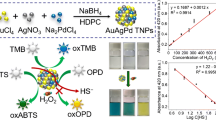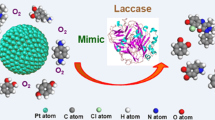Abstract
Catechol is demonstrated as a versatile reducing agent/stabilizing agent for the facile and one pot synthesis of monometallic (Au, Se and Pd) and bimetallic nanoparticles in alkaline condition (pH = 11) based on the redox chemistry of catechol. Catechol-derived PdNPs and SeNPs exhibit laccase and peroxidase like activity, respectively. Catechol derived gold nanoparticles serving as an excellent support for enzyme immobilization with recyclable properties are also reported here. As a test model protienase k immobilized on gold nanoparticles exhibits significant biocatalytic activities without compromising the enzyme activity. In summary. this work offers a versatile reducing agent for nanoparticle synthesis and demonstrates new generation of artificial enzymes.
Graphical abstract
Catechol is explored toward the synthesis of monometallic (Au, Pd, Se) and their corresponding bimetallic nanoparticles and they are found to behave like artificial enzymes











Similar content being viewed by others
References
Ahmad T, Bustam MA, Irfan M et al (2019) Mechanistic investigation of phytochemicals involved in green synthesis of gold nanoparticles using aqueous Elaeis guineensis leaves extract: role of phenolic compounds and flavonoids. Biotechnol Appl Biochem 66:698–708
Nune SK, Chanda N, Shukla R et al (2009) Green nanotechnology from tea: phytochemicals in tea as building blocks for production of biocompatible gold nanoparticles. J Mater Chem 19:2912–2920
Guo D, Dou D, Ge L et al (2015) A caffeic acid mediated facile synthesis of silver nanoparticles with powerful anti-cancer activity. Colloids Surfac B Biointerfaces 134:229–234
Kim TY, Cha S-H, Cho S, Park Y (2016) Tannic acid-mediated green synthesis of antibacterial silver nanoparticles. Arch Pharm Res 39:465–473
Chen Y-J, Lee Y-C, Huang C-H, Chang L-S (2016) Gallic acid-capped gold nanoparticles inhibit EGF-induced MMP-9 expression through suppression of p300 stabilization and NFκB/c-Jun activation in breast cancer MDA-MB-231 cells. Toxicol Appl Pharmacol 310:98–107
Hwang SJ, Jun SH, Park Y et al (2015) Green synthesis of gold nanoparticles using chlorogenic acid and their enhanced performance for inflammation. Nanomed Nanotechno Biol Med 11:1677–1688
Dauthal P, Mukhopadhyay M (2016) Noble metal nanoparticles: plant-mediated synthesis, mechanistic aspects of synthesis, and applications. Ind Eng Chem Res 55:9557–9577
Kim HJ, Kim D, Yoon H et al (2015) Polyphenol/FeIII complex coated membranes having multifunctional properties prepared by a one-step fast assembly. Adv Mater Interfaces 2:1500298
Suherman AL, Kuss S, Tanner EEL et al (2018) Electrochemical Hg 2+ detection at tannic acid-gold nanoparticle modified electrodes by square wave voltammetry. Analyst 143:2035–2041
Wu Y-S, Huang F-F, Lin Y-W (2013) Fluorescent detection of lead in environmental water and urine samples using enzyme mimics of catechin-synthesized Au nanoparticles. ACS Appl Mater Interfaces 5:1503–1509
Jena S, Singh RK, Panigrahi B et al (2016) Photo-bioreduction of Ag+ ions towards the generation of multifunctional silver nanoparticles: mechanistic perspective and therapeutic potential. J Photochem Photobiol B Biol 164:306–313
Singh RK, Mishra S, Jena S et al (2018) Rapid colorimetric sensing of gadolinium by EGCG-derived AgNPs: the development of a nanohybrid bioimaging probe. Chem Commun 54:3981–3984
Singh RK, Panigrahi B, Mishra S et al (2018) pH triggered green synthesized silver nanoparticles toward selective colorimetric detection of kanamycin and hazardous sulfide ions. J Mol Liq 269:269–277
Khoobchandani M, Katti K, Maxwell A et al (2016) Laminin receptor-avid nanotherapeutic EGCg-AuNPs as a potential alternative therapeutic approach to prevent restenosis. Int J Mol Sci 17:316
Ma Y, Niu H, Cai Y (2011) Colorimetric detection of copper ions in tap water during the synthesis of silver/dopamine nanoparticles. Chem Commun 47:12643–12645
Marcelo G, Fernández-García M (2014) Direct preparation of PNIPAM coating gold nanoparticles by catechol redox and surface adhesion chemistry. RSC Adv 4:11740–11749
Wu J, Zhang L, Wang Y et al (2011) Mussel-inspired chemistry for robust and surface-modifiable multilayer films. Langmuir 27:13684–13691
Black KCL, Liu Z, Messersmith PB (2011) Catechol redox induced formation of metal core− polymer shell nanoparticles. Chem Mater 23:1130–1135
Sedó J, Saiz-Poseu J, Busqué F, Ruiz-Molina D (2013) Biomimetics: catechol-based biomimetic functional materials (Adv. Mater. 5/2013). Adv Mater 25:792
Roy AK, Park SY, In I (2015) Mussel-inspired synthesis of boron nitride nanosheet-supported gold nanoparticles and their application for catalytic reduction of 4-nitrophenol. Nanotechnology 26:105601
Faure E, Falentin-Daudré C, Jérôme C et al (2013) Catechols as versatile platforms in polymer chemistry. Prog Polym Sci 38:236–270
Marcelo G, Munoz-Bonilla A, Rodríguez-Hernández J, Fernández-García M (2013) Hybrid materials achieved by polypeptide grafted magnetite nanoparticles through a dopamine biomimetic surface anchored initiator. Polym Chem 4:558–567
Zhang L, Wu J, Wang Y et al (2012) Combination of bioinspiration: a general route to superhydrophobic particles. J Am Chem Soc 134:9879–9881
Gebru H, Cui S, Li Z et al (2017) Facile pH-Dependent synthesis and characterization of catechol stabilized silver nanoparticles for catalytic reduction of 4-Nitrophenol. Catal Letters 147:2134–2143
Jiao X, Song H, Zhao H et al (2012) Well-redispersed ceria nanoparticles: promising peroxidase mimetics for H 2 O 2 and glucose detection. Anal Methods 4:3261–3267
Mu J, Wang Y, Zhao M, Zhang L (2012) Intrinsic peroxidase-like activity and catalase-like activity of Co 3 O 4 nanoparticles. Chem Commun 48:2540–2542
Wang X-X, Wu Q, Shan Z, Huang Q-M (2011) BSA-stabilized Au clusters as peroxidase mimetics for use in xanthine detection. Biosens Bioelectron 26:3614–3619
Liu J, Hu X, Hou S et al (2011) Screening of inhibitors for oxidase mimics of Au@ Pt nanorods by catalytic oxidation of OPD. Chem Commun 47:10981–10983
Zhou Y-T, He W, Wamer WG et al (2013) Enzyme-mimetic effects of gold@ platinum nanorods on the antioxidant activity of ascorbic acid. Nanoscale 5:1583–1591
Lin Y, Ren J, Qu X (2014) Catalytically active nanomaterials: a promising candidate for artificial enzymes. Acc Chem Res 47:1097–1105
Wei H, Wang E (2013) Nanomaterials with enzyme-like characteristics (nanozymes): next-generation artificial enzymes. Chem Soc Rev 42:6060–6093
Long YJ, Li YF, Liu Y et al (2011) Visual observation of the mercury-stimulated peroxidase mimetic activity of gold nanoparticles. Chem Commun 47:11939–11941
Wang S, Chen W, Liu A et al (2012) Comparison of the peroxidase-like activity of unmodified, amino-modified, and citrate-capped gold nanoparticles. ChemPhysChem 13:1199–1204
Fan J, Yin J-J, Ning B et al (2011) Direct evidence for catalase and peroxidase activities of ferritin–platinum nanoparticles. Biomaterials 32:1611–1618
Natalio F, André R, Hartog AF et al (2012) Vanadium pentoxide nanoparticles mimic vanadium haloperoxidases and thwart biofilm formation. Nat Nanotechnol 7:530–535
Asati A, Santra S, Kaittanis C et al (2009) Oxidase-like activity of polymer-coated cerium oxide nanoparticles. Angew Chemie 121:2344–2348
Shi W, Wang Q, Long Y et al (2011) Carbon nanodots as peroxidase mimetics and their applications to glucose detection. Chem Commun 47:6695–6697
Dong Y, Chi Y, Lin X et al (2011) Nano-sized platinum as a mimic of uricase catalyzing the oxidative degradation of uric acid. Phys Chem Chem Phys 13:6319–6324
Jiang C, Zhu J, Li Z et al (2017) Chitosan–gold nanoparticles as peroxidase mimic and their application in glucose detection in serum. RSC Adv 7:44463–44469
Fu Y, Zhang H, Dai S et al (2015) Glutathione-stabilized palladium nanozyme for colorimetric assay of silver (I) ions. Analyst 140:6676–6683
Mazumder V, Sun S (2009) Oleylamine-mediated synthesis of Pd nanoparticles for catalytic formic acid oxidation. J Am Chem Soc 131:4588–4589
Yang Z, Zhang Z, Jiang Y et al (2016) Palladium nanoparticles modified electrospun CoFe 2 O 4 nanotubes with enhanced peroxidase-like activity for colorimetric detection of hydrogen peroxide. RSC Adv 6:33636–33642
Reshmi R, Sanjay G, Sugunan S (2007) Immobilization of α-amylase on zirconia: a heterogeneous biocatalyst for starch hydrolysis. Catal Commun 8:393–399
Betzel C, Gourinath S, Kumar P et al (2001) Structure of a serine protease proteinase K from tritirachium album limber at 0.98 Å resolution. Biochemistry 40:3080–3088
Stone LA, Jackson GS, Collinge J et al (2007) Inhibition of proteinase K activity by copper (II) ions. Biochemistry 46:245–252
Bayramoglu G, Kayili HM, Oztekin M, et al (2020) Hydrophilic spacer-arm containing magnetic nanoparticles for immobilization of proteinase K: Employment for speciation of proteins for mass spectrometry-based analysis. Talanta 206:120218file:///C:/Users/User/Downloads/scholar (3).
Balla J, Kiss T, Jameson RF (1992) Copper (II)-catalyzed oxidation of catechol by molecular oxygen in aqueous solution. Inorg Chem 31:58–62
Tomaszewska E, Soliwoda K, Kadziola K et al (2013) Detection limits of DLS and UV-Vis spectroscopy in characterization of polydisperse nanoparticles colloids. J Nanomater. https://doi.org/10.1155/2013/313081
Cooray MCD, Liu Y, Langford SJ et al (2015) One pot synthesis of poly (5-hydroxyl-1, 4-naphthoquinone) stabilized gold nanoparticles using the monomer as the reducing agent for nonenzymatic electrochemical detection of glucose. Anal Chim Acta 856:27–34
Prashant J, Gary H (2011) The catalytic role of uranyl in formation of polycatechol complexes. Chem Cent J 5(1):1–7
Sahay R, Yadav RSS, Yadava S, Yadav KDS (2012) A laccase of fomes durissimus MTCC-1173 and Its role in the conversion of methylbenzene to benzaldehyde. Appl Biochem Biotechnol 166:563–575
Sharma RV, Soni KK, Dalai AK (2012) Preparation, characterization and application of sulfated Ti-SBA-15 catalyst for oxidation of benzyl alcohol to benzaldehyde. Catal Commun 29:87–91
Necsoiu I, Balaban AT, Pascaru I et al (1963) The mechanism of the etard reaction. Tetrahedron 19:1133–1142
Wendlandt AE, Stahl SS (2015) Quinone-catalyzed selective oxidation of organic molecules. Angew Chemie Int Ed 54:14638–14658
Li L, Wang W, Chen K (2014) Synthesis of black elemental selenium peroxidase mimic and its application in green synthesis of water-soluble polypyrrole as a photothermal agent. J Phys Chem C 118:26351–26358
Huang Y, Liu C, Pu F et al (2017) A GO–Se nanocomposite as an antioxidant nanozyme for cytoprotection. Chem Commun 53:3082–3085
Gao L, Zhuang J, Nie L et al (2007) Intrinsic peroxidase-like activity of ferromagnetic nanoparticles. Nat Nanotechnol 2:577–583
Petrotchenko EV, Serpa JJ, Hardie DB et al (2012) Use of proteinase K nonspecific digestion for selective and comprehensive identification of interpeptide cross-links: application to prion proteins. Mol Cell Proteomics 11:M111-013524
Anderson J, Byrne T, Woelfel KJ et al (1994) The hydrolysis of p-nitrophenyl acetate: a versatile reaction to study enzyme kinetics. J Chem Educ 71:715
Acknowledgements
The authors gratefully acknowledge the financial support by the Department of Science & Technology-Nanomission, India (Grant no. SR/NM/NS-1075/2013), Department of Biotechnology, India (grant no.BT/PR10019/NNT/28/708/2013) and Department of Atomic Energy, India (BRNS Grant no. 37(2)/14/22/2015/BRNS/37172), Govt. of India to DM. SM acknowledges the financial support from Indian Council of Medical Research (ICMR), Govt. of India, for providing Senior Research Fellowship (SRF) award (45/43/2019-NAN-BMS).
Author information
Authors and Affiliations
Contributions
SM, BP and RKS conducted all the experiments. SM drafted the primary manuscript. DM supervised the overall project and edited the manuscript.
Corresponding author
Ethics declarations
Conflict of interest
There are no conflicts to declare.
Additional information
Publisher's Note
Springer Nature remains neutral with regard to jurisdictional claims in published maps and institutional affiliations.
Supplementary Information
Below is the link to the electronic supplementary material.
Rights and permissions
About this article
Cite this article
Mishra, S., Panigrahi, B., Singh, R.K. et al. Catechol Mediated Synthesis of Monometallic and Bimetallic Nanoparticles and Catalytic Efficiency of Monometallic Nanoparticles. Catal Lett 153, 1602–1614 (2023). https://doi.org/10.1007/s10562-022-04095-z
Received:
Accepted:
Published:
Issue Date:
DOI: https://doi.org/10.1007/s10562-022-04095-z




